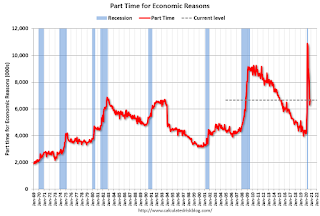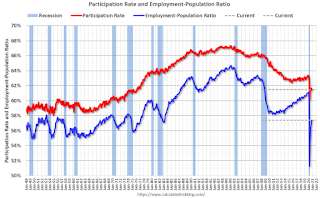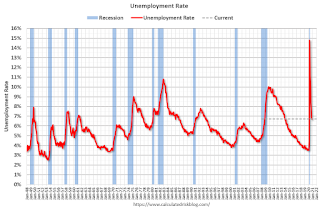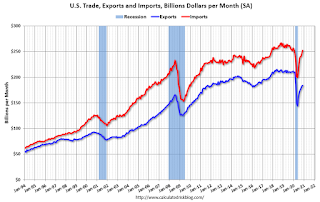by Calculated Risk on 1/08/2021 09:58:00 AM
Friday, January 08, 2021
Comments on December Employment Report
The headline jobs number in the December employment report was well below expectations, however employment for the previous two months was revised up significantly.
Leisure and hospitality lost 498 thousand jobs in December due to the surging pandemic. In March and April, leisure and hospitality lost 8.3 million jobs, and then gained about 60% of those jobs back. With the December job losses, leisure and hospitality is down 3.9 million jobs since February 2020.
Earlier: December Employment Report: 140 Thousand Jobs LOST, 6.7% Unemployment Rate
In December, the year-over-year employment change was minus 9.37 million jobs.
Permanent Job Losers
 Click on graph for larger image.
Click on graph for larger image.This graph shows permanent job losers as a percent of the pre-recession peak in employment through the November report. (ht Joe Weisenthal at Bloomberg)
This data is only available back to 1994, so there is only data for three recessions.
In December, the number of permanent job losers decreased to 3.370 million from 3.718 million in November. This is good news.
Prime (25 to 54 Years Old) Participation
 Since the overall participation rate has declined due to cyclical (recession) and demographic (aging population, younger people staying in school) reasons, here is the employment-population ratio for the key working age group: 25 to 54 years old.
Since the overall participation rate has declined due to cyclical (recession) and demographic (aging population, younger people staying in school) reasons, here is the employment-population ratio for the key working age group: 25 to 54 years old.The prime working age will be key in the eventual recovery.
The 25 to 54 participation rate increased in December to 81.0% from 80.9% in November, and the 25 to 54 employment population ratio increased to 76.3% from 76.0% in November.
Seasonal Retail Hiring
Typically retail companies start hiring for the holiday season in October, and really increase hiring in November. Here is a graph that shows the historical net retail jobs added for October, November and December by year.
 This graph really shows the collapse in retail hiring in 2008. Since then seasonal hiring had increased back close to more normal levels. Note: I expect the long term trend will be down with more and more internet holiday shopping.
This graph really shows the collapse in retail hiring in 2008. Since then seasonal hiring had increased back close to more normal levels. Note: I expect the long term trend will be down with more and more internet holiday shopping.Retailers hired 230 thousand workers (NSA) net in December. Note: this is NSA (Not Seasonally Adjusted). This was a gain of 121 thousand jobs, seasonally adjusted, in December.
This might be distorted this year by a combination of seasonal hiring - and some bounce back in employment from the shutdowns earlier this year. But this an unexpected large gain for retail.
Part Time for Economic Reasons
 From the BLS report:
From the BLS report:"The number of persons employed part time for economic reasons, at 6.2 million, decreased by 471,000 over the month. This measure is down from its April high of 10.9 million but is 1.8 million higher than the February level. These individuals, who would have preferred full-time employment, were working part time because their hours had been reduced or they were unable to find full-time jobs."The number of persons working part time for economic reasons decreased in December to 6.170 million from 6.641 million in November.
These workers are included in the alternate measure of labor underutilization (U-6) that decreased to 11.7% in December. This is down from the record high in April 22.9% for this measure since 1994.
Unemployed over 26 Weeks
 This graph shows the number of workers unemployed for 27 weeks or more.
This graph shows the number of workers unemployed for 27 weeks or more. According to the BLS, there are 3.956 million workers who have been unemployed for more than 26 weeks and still want a job.
This will be a key measure to follow during the recovery.
Summary:
The headline monthly jobs number was well below expectations, however the previous two months were revised up 135,000 combined. The headline unemployment rate was unchanged at 6.7%.
December Employment Report: 140 Thousand Jobs LOST, 6.7% Unemployment Rate
by Calculated Risk on 1/08/2021 08:43:00 AM
From the BLS:
Total nonfarm payroll employment declined by 140,000 in December, and the unemployment rate was unchanged at 6.7 percent, the U.S. Bureau of Labor Statistics reported today. The decline in payroll employment reflects the recent increase in coronavirus (COVID-19) cases and efforts to contain the pandemic. In December, job losses in leisure and hospitality and in private education were partially offset by gains in professional and business services, retail trade, and construction.
...
The change in total nonfarm payroll employment for October was revised up by 44,000, from +610,000 to +654,000, and the change for November was revised up by 91,000, from +245,000 to +336,000. With these revisions, employment in October and November combined was 135,000 more than previously reported.
emphasis added
 Click on graph for larger image.
Click on graph for larger image.The first graph shows the year-over-year change in total non-farm employment since 1968.
In December, the year-over-year change was negative 9.37 million jobs.
Total payrolls decreased by 140 thousand in December. Private payrolls decreased by 95 thousand.
Payrolls for October and November were revised up 135 thousand combined.
 The second graph shows the job losses from the start of the employment recession, in percentage terms.
The second graph shows the job losses from the start of the employment recession, in percentage terms.The current employment recession is by far the worst recession since WWII in percentage terms, and is still worse than the worst of the "Great Recession".
The third graph shows the employment population ratio and the participation rate.
 The Labor Force Participation Rate was unchanged at 61.5% in December. This is the percentage of the working age population in the labor force.
The Labor Force Participation Rate was unchanged at 61.5% in December. This is the percentage of the working age population in the labor force. The Employment-Population ratio was unchanged at 57.4% (black line).
I'll post the 25 to 54 age group employment-population ratio graph later.
 The fourth graph shows the unemployment rate.
The fourth graph shows the unemployment rate. The unemployment rate was unchanged in December at 6.7%.
This was well below consensus expectations, however October and November were revised up by 135,000 combined.
I'll have much more later …
Thursday, January 07, 2021
Friday: Employment Report
by Calculated Risk on 1/07/2021 09:23:00 PM
My December Employment Preview
Goldman December Payrolls Preview
Friday:
• At 8:30 AM ET, Employment Report for December. The consensus is for 70 thousand jobs added, and for the unemployment rate to increase to 6.8%.

This graph shows the job losses from the start of the employment recession, in percentage terms through November.
The current employment recession was by far the worst recession since WWII in percentage terms, and the worst in terms of the unemployment rate.
January 7 COVID-19 Test Results; Record 7-Day Deaths and Cases
by Calculated Risk on 1/07/2021 07:51:00 PM
The US is now averaging close to 2 million tests per day. Based on the experience of other countries, for adequate test-and-trace (and isolation) to reduce infections, the percent positive needs to be under 5% (probably close to 1%), so the US has far too many daily cases - and percent positive - to do effective test-and-trace.
There were 1,914,839 test results reported over the last 24 hours.
There were 266,197 positive tests.
Over 19,000 US deaths have been reported so far in January. See the graph on US Daily Deaths here.
 Click on graph for larger image.
Click on graph for larger image.This data is from the COVID Tracking Project.
The percent positive over the last 24 hours was 13.9% (red line is 7 day average). The percent positive is calculated by dividing positive results by total tests (including pending).
And check out COVID Act Now to see how each state is doing. (updated link to new site)
 The second graph shows the 7 day average of positive tests reported and daily hospitalizations.
The second graph shows the 7 day average of positive tests reported and daily hospitalizations.• Record 7-Day Deaths
• Record 7-Day Cases
Goldman December Payrolls Preview
by Calculated Risk on 1/07/2021 03:10:00 PM
A few brief excerpts from a note by Goldman Sachs economist Spencer Hill:
We estimate nonfarm payrolls declined 50k in December ... most of the Big Data employment signals we track indicate an outright decline in payrolls. Additionally, restaurant seatings fell back to July levels, and initial claims rose for the first time since April. ... We estimate the unemployment rate rebounded a tenth to 6.8%CR Note: The consensus is for 70 thousand jobs added, and for the unemployment rate to increase to 6.8%.
emphasis added
December Employment Preview
by Calculated Risk on 1/07/2021 01:05:00 PM
On Friday at 8:30 AM ET, the BLS will release the employment report for December. The consensus is for 70 thousand jobs added, and for the unemployment rate to increase to 6.8%.
• ADP Report: The ADP employment report showed a loss of 123,000 private sector jobs, well below the consensus estimate of 88 thousand jobs added. The ADP report hasn't been very useful in predicting the BLS report, but this suggests the BLS report could be weaker than expected.
• ISM Surveys: The ISM manufacturing employment index increased in December to 51.5%, up from 48.4% in November. This would suggest essentially approximately 10,000 manufacturing jobs lost in December. ADP showed 21,000 manufacturing jobs lost.
The ISM Services employment index decreased in December to 48.2% from 51.5% in November. This would suggest around 25,000 service jobs added in December. Combined, the ISM surveys suggest around 15,000 private sector jobs added in December. The ISM surveys haven't been as useful as usual during the pandemic, but this does suggest the report could be weaker than expected.
• Unemployment Claims: The weekly claims report showed a high number of total continuing unemployment claims during the reference week, although this might not be very useful right now. If we did a "Rip Van Winkle", and saw the weekly claims report this morning, we'd think the economy was in a deep recession!

Click on graph for larger image.
In 2019, retailers hired 79,500 seasonal employees (NSA) in December. That translated to a gain of 41,000 SA. Brick and Mortar retailers will be more cautious this year, and retail might decline a little SA in December.
 • Permanent Job Losers: Something to watch in the employment report will be "Permanent job losers". While there has been a strong bounce back in total employment, from the shutdown in March and April, permanent job losers have been increasing.
• Permanent Job Losers: Something to watch in the employment report will be "Permanent job losers". While there has been a strong bounce back in total employment, from the shutdown in March and April, permanent job losers have been increasing.This graph shows permanent job losers as a percent of the pre-recession peak in employment through the November report.
This data is only available back to 1994, so there is only data for three recessions. In November, the number of permanent job losers increased to 3.743 million from 3.684 million in October.
• Conclusion: Most of the indicators suggest a weak report in December. My guess is the report will be lower than the consensus, and could show jobs lost in December.
Hotels: Occupancy Rate Declined 17.2% Year-over-year
by Calculated Risk on 1/07/2021 11:49:00 AM
Thanks to a travel boost leading into the New Year’s holiday, U.S. weekly hotel occupancy improved noticeably from the previous week, according to STR‘s latest data through 2 January.The following graph shows the seasonal pattern for the hotel occupancy rate using the four week average.
27 December 2020 through 2 January 2021 (percentage change from comparable week in 2019/2020):
• Occupancy: 40.6% (-17.2%)
• Average daily rate (ADR): US$107.93 (-21.5%)
• Revenue per available room (RevPAR): US$43.81 (-35.1%)
Hotel demand jumped in week-over-comparisons while TSA checkpoint counts showed five days with more than 1 million passengers. Substantial hotel demand growth is not expected to continue as leisure travel once again dissipates after the holidays.
emphasis added
 Click on graph for larger image.
Click on graph for larger image.The red line is for 2021, black is 2020, blue is the median, and dashed light blue is for 2009 (the worst year since the Great Depression for hotels - before 2020).
Seasonally we'd expect business travel would start to pick up in the new year, but there will probably not be much pickup early this year.
Note: Y-axis doesn't start at zero to better show the seasonal change.
ISM Services Index Increased to 57.2% in December
by Calculated Risk on 1/07/2021 10:09:00 AM
The December ISM Services index was at 57.2%, up from 55.9% last month. The employment index decreased to 48.2%, from 51.5%. Note: Above 50 indicates expansion, below 50 contraction.
From the Institute for Supply Management: Services PMI™ at 57.2%; December 2020 Services ISM® Report On Business®
Economic activity in the services sector grew in December for the seventh month in a row, say the nation's purchasing and supply executives in the latest Services ISM® Report On Business®.
The report was issued today by Anthony Nieves, CPSM, C.P.M., A.P.P., CFPM, Chair of the Institute for Supply Management® (ISM®) Services Business Survey Committee: "The Services PMI™ registered 57.2 percent, 1.3 percentage points higher than the November reading of 55.9 percent. This reading represents a seventh straight month of growth for the services sector, which has expanded for all but two of the last 131 months.
emphasis added
Trade Deficit Increased to $68.1 Billion in November
by Calculated Risk on 1/07/2021 08:54:00 AM
From the Department of Commerce reported:
The U.S. Census Bureau and the U.S. Bureau of Economic Analysis announced today that the goods and services deficit was $68.1 billion in November, up $5.0 billion from $63.1 billion in October, revised.
November exports were $184.2 billion, $2.2 billion more than October exports. November imports were $252.3 billion, $7.2 billion more than October imports.
emphasis added
 Click on graph for larger image.
Click on graph for larger image.Both exports and imports increased in November.
Exports are down 12.5% compared to November 2019; imports are unchanged compared to November 2019.
Both imports and exports decreased sharply due to COVID-19, and have now bounced back (imports much more than exports),
The second graph shows the U.S. trade deficit, with and without petroleum.
 The blue line is the total deficit, and the black line is the petroleum deficit, and the red line is the trade deficit ex-petroleum products.
The blue line is the total deficit, and the black line is the petroleum deficit, and the red line is the trade deficit ex-petroleum products.Note that the U.S. exported a slight net positive petroleum products in recent months.
Oil imports averaged $35.68 per barrel in November, down from $36.23 per barrel in October, and down from $51.91 in November 2019.
The trade deficit with China increased to $30.7 billion in November, from $26.3 billion in November 2019.
Weekly Initial Unemployment Claims at 787,000
by Calculated Risk on 1/07/2021 08:39:00 AM
The DOL reported:
In the week ending January 2, the advance figure for seasonally adjusted initial claims was 787,000, a decrease of 3,000 from the previous week's revised level. The previous week's level was revised up by 3,000 from 787,000 to 790,000. The 4-week moving average was 818,750, a decrease of 18,750 from the previous week's revised average. The previous week's average was revised up by 750 from 836,750 to 837,500.This does not include the 161,460 initial claims for Pandemic Unemployment Assistance (PUA) that was down from 310,462 the previous week.
emphasis added
The following graph shows the 4-week moving average of weekly claims since 1971.
 Click on graph for larger image.
Click on graph for larger image.The dashed line on the graph is the current 4-week average. The four-week average of weekly unemployment claims decreased to 818,750.
The previous week was revised up.
The second graph shows seasonally adjust continued claims since 1967 (lags initial by one week).
 At the worst of the Great Recession, continued claims peaked at 6.635 million, but then steadily declined.
At the worst of the Great Recession, continued claims peaked at 6.635 million, but then steadily declined.Continued claims decreased to 5,072,000 (SA) from 5,198,000 (SA) last week and will likely stay at a high level until the crisis abates.
Note: There are an additional 8,383,387 receiving Pandemic Unemployment Assistance (PUA) that decreased from 8,453,940 the previous week (there are questions about these numbers). This is a special program for business owners, self-employed, independent contractors or gig workers not receiving other unemployment insurance.


